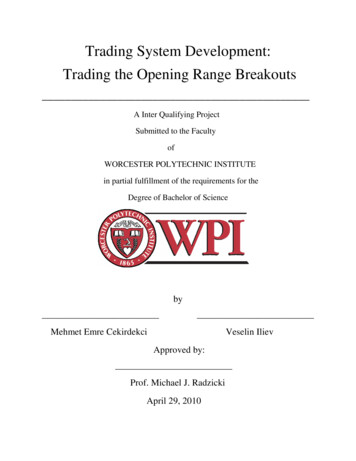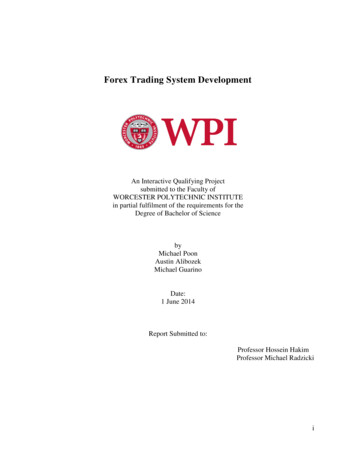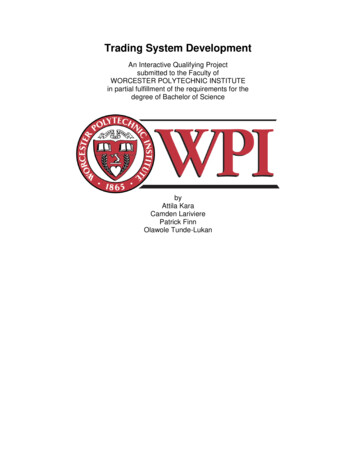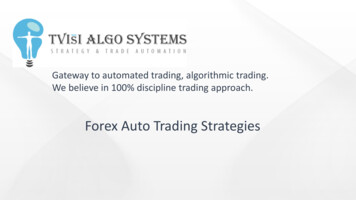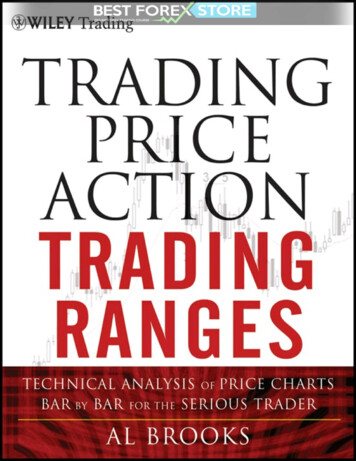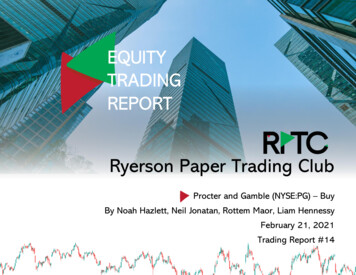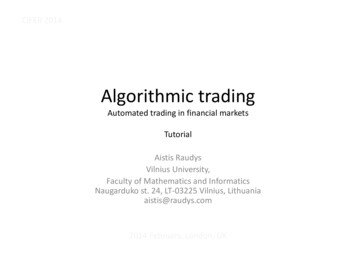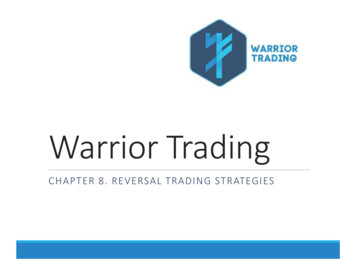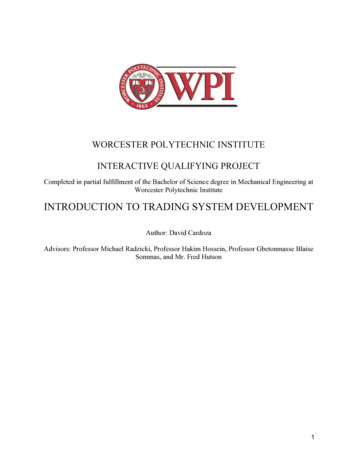
Transcription
WORCESTER POLYTECHNIC INSTITUTEINTERACTIVE QUALIFYING PROJECTCompleted in partial fulfillment of the Bachelor of Science degree in Mechanical Engineering atWorcester Polytechnic InstituteINTRODUCTION TO TRADING SYSTEM DEVELOPMENTAuthor: David CardozaAdvisors: Professor Michael Radzicki, Professor Hakim Hossein, Professor Gbetonmasse BlaiseSommas, and Mr. Fred Hutson1
.TABLE OF CONTENTS:CHAPTER 1: INTRODUCTION AND OVERVIEW OF RESEARCH .41.1 PROBLEM STATEMENT . . .41.2 IMPORTANCE OF PROBLEM . 41.3 LITERATURE SUMMARY AND STATEMENT OF CREATIVITY .51.4 CONCLUSIONS . . . .6CHAPTER 2: TRADING AND INVESTING .72.1 OVERVIEW 72.2 STOCK MARKET AND "BEATING THE MARKET" .92.3 BULL AND BEAR MARKETS . .112.4 ASSET CLASSES . . .12CHAPTER 3: TRADING SYSTEMS . .143.1 TRADING SYSTEM OVERVIEW . 143.2 TRADING PLATFORMS AND BROKERAGES . .153.3 GROWTH AND VALUE INVESTING . .153.4 TRADING STYLES . 16CHAPTER 4: OPTIMIZING AND ANALYZING TRADESTATION .194.1 OVERVIEW . 194.2 VALUE OF MANAGING A SYSTEM OF SYSTEMS .194.3 EXPECTANCY, EXPECTUNITY, AND SYSTEM QUALITY .204.4 WALK FORWARD ANALYSIS . 20CHAPTER 5: LITERATURE REVIEW. . . .225.1 CANSLIM STOCK SELECTION . .225.2 TREND FOLLOWING "SMOOTHIES" STRATEGY .235.3 MOVING AVERAGE CROSSOVER STRATEGY .24CHAPTER 6: TREND-FOLLOWING SYSTEM . 256.1 OVERVIEW . . .256.2 STOCK SELECTION . .266.3 TREND FOLLOWING AUTOMATIC ALGORITHM . .27CHAPTER 7: MOVING AVERAGE CROSSOVER SYSTEM. . . .297.1 OVERVIEW . . . 297.2 MOVING AVERAGE CROSSOVER ALGORITHM .29CHAPTER 8: SYSTEM OF SYSTEMS. .328.1 PORTFOLIO MAESTRO . 328.2 INDIVIDUAL ANALYSIS . .33CHAPTER 9: SUMMARY AND CONCLUSIONS . 40WORKS CITED . . 412
LIST OF FIGURESFIGURE 1: Visual explanation of support and resistance lines. . . .23FIGURE 2: Code for the Trend-following strategy . . . 25FIGURE 3: BA Daily chart with the trend-following system trade times. . . . .27FIGURE 4: Equity Curve for BA Daily, using the trend-following Strategy . . . 28FIGURE 5: Code for Moving Average Crossover Strategy . . . .29FIGURE 6: Boeing stock chart with daily bars, and optimizeD moving average lines. . .30FIGURE 7: Equity Curve of BA Daily using Moving Crossover strategy . . . . .31FIGURE 8: Figure 8: System quality and weighted allocation of funds chart . . .32FIGURE 9: Aggregate equity curve obtained from Portfolio Maestro, the first system of systems. .33FIGURE 10: Aggregate Monte Carlo chart showing the probability of average return per trade .34FIGURE 11 and 12: Total equity chart data summary. . . . . . . . . .35FIGURE 13 and 14: Total Monte Carlo Analysis . . .36FIGURE 15: Aggregate equity chart of the system of systems, with weighted allocations . 38FIGURE 16: Aggregate equity chart of the system of systems, without weighted allocations. . 393
Chapter 1: Introduction and Overview of Research1.1. Problem statementThe purpose of this project is to build a trading system that uses scientific methods to ensure profitability.Creating a science-based trading system allows for an investor to design a trading system and portfoliousing logic rather than emotion. This creates a trading strategy that can keep a trader from making costlymistakes that usually arise from relying on their intuition and “gut” feelings. Because asset traders arehumans and not computers, they have emotions that can prevent them from making smart trades, even ifthey are experienced traders and know when to make a trade.1.2. Importance of problemThe reliability of using logical criteria to create trades is one reason that professional stockmarket traders use quantitative trading. By using quantitative trading, traders can make better trades,which are based on scientific and statistical knowledge. Thus, an algorithmic trading system designed totrade on objective criteria prevents these emotions from ruining a trader’s portfolio. Therefore, thisproject involved creating an automatic trading system designed to run on the trading platformTradeStation.Methods including statistical analysis and mathematical modeling are implemented in order tofully optimize the trading system for use in the stock market. In this project, it is proven that scientificanalysis is an efficient method for analyzing and writing trading programs. In addition, when the tradingsystem is properly written and tested, the advantages of automatic trading outweigh the disadvantages ofmanual trading for multiple reasons. These include, but are not limited to: prevention of user error,trading consistency, and proven trading methods.Statistically-backed information is utilized in the program to decide when to create trades, andthis reduces errors caused by human interference and bias. Often times, being unsure of a trade causespeople to make bad choices that result in losing money. In addition, relying on manual trading is astrategy that is prone to user forgetfulness and unreliability. By trading automatically through computerprograms, emotions can no longer interfere with trades since the system relies on math and scientific4
objective criteria to trade (Folger). These criteria, of course, have been determined to be statistically likelyto accomplish the trader's goals. Also, trades traded by an automatic system will always be ordered to thestock broker, since the computer program cannot accidentally forget about the trade. Lastly, automaticallytrading is a strategy that can be built and improved upon over time, with little effort.1.3. Literature summary and statement of creativityFor the automatic trading system, stocks were traded in swing trading time frames. Two algorithmicstrategies were written and back tested with historical data, and both strategies were combined into two"system of systems" that allowed analysis of the portfolio of stocks. These two strategies were based on:1) Trend-following resistance and support trendline charts2) Moving Average crossover philosophies.Additionally, analytical techniques such as Monte Carlo analysis and Walk Forward Optimizationwere used to determine the allocation of funds to each stock inside of a "system of systems" portfolio.The purpose of a dual “system of systems” is to build a reliably profitable strategy for creatingfunds. By allocating money to each of the two systems depending on the potential expected rewardgained, the entire strategy can be depended upon to create funds regardless on the individual stocks in thesystem or the economic performance of the market. Also, adapting the allocation of money andimportance to both systems allows the “weight” of the entire “system of systems” to be calculated andoptimized.In both systems, the strategy made use of a unique stock selection method known as the“CANSLIM” method, which chooses strongly performing stocks to trade (Chen, CANSLIM). This stockselection, in tandem with the technical analysis chart trading method of using trendline support andresistance lines, is best used for trading during times of rapidly changing prices over the course of weeksand months of slow price increases. The price level reaches one of the resistance or support lines when asharp price change happens, and this is exploited in this strategy, by finding this sharp changes.The use of support and resistance lines is implemented in a trend-following system for the first ofthe two systems. A trend following system is a trading system in which trades are created that effectively5
use the price level movement of a stock as a way to gauge when trades should be made. When the price ispredicted by the system to increase, then the trend following strategy will purchase the stock. Likewise,when the system predicts the system will decrease, then the system will sell the stock that was previouslypurchased. This trendfollowing method a common method used by traders.The second system conducts trades based on a moving average cross-over strategy, in tandemwith a trend following system, that follows the trends of the moving averages in specific to conducttrades. Two moving average lines were used, and optimized for each stock, to create a system. Usinghistorical data, the system calculates the best time range for the fast and slow moving average lines, andcreates trades when the the “fast” moving average line crosses over and under the “slow” moving averageline.For the purpose of this project, the system was created on a simulated trading platform for thesake of implementing an operable code. Funds allocated by the system were not evaluated in terms offeasibility or actual implementation. Thus, commission fees and waiting periods are just two factors thatmust be considered before actually implementing this strategy.This code was written with my own psychological preferences, and the purpose of doing this willbe included later in the paper. To briefly explain, a trader’s adversity to risk, and his/her propensity toinvest and trade money, will be an important factor in how they decide to conduct trades.1.4. ConclusionsThrough these analytical techniques, it was found that creating automated trading systems is a profitableventure, as using scientific methods to build and optimize trading algorithms can vastly improve resultsrelative to solely relying on traditional methods such as chart reading.6
Chapter 2: Trading & Investing2.1. Trading & Investing OverviewIn financial management, the allocation and earning of money is done in the stock market throughtrading and investing strategies. These two approaches are the most commonly implemented strategies inthe stock market. Traders, investors, and everyday people trade financial assets on the stock exchange forprofits. Each individual person who trades must create strategies for reliable success, regardless of theirmindset or preferred strategy.Trading strategies typically involve buying and selling financial assets more frequently than aninvesting strategy. This is done by exploiting the changes in price of an asset class, and purchasing,selling these asset classes to make profit. This is done, usually, by holding and then selling an asset in thetime frame of anywhere from a few nanoseconds to months to even multiple years. Various time framesappeal to various mindsets, and these will be discussed in further detail in Chapter 3.The mindset of traders is short term profits with minimized risk of losing out on money-makingopportunities in the short term. In addition, traders prefer to use the price level of an asset class asindication of trading potential rather than an individual asset's financial performance. Also, traders are notinterested in an assets performance or purpose, instead focusing on how to take advantage of the changesin price of its shares in order to make profitable trades.Trading assets brings the advantages and disadvantages that arise from holding onto assets forshort periods of time. For instance, a trader does not necessarily have to watch the company’sperformance in the news, and can trade any asset that has large price movement. In addition, traders canget out of a bad trade quickly, because their money is not held up.However, trading in short term strategies has disadvantages as well. Trading assets frequentlyrequires commission costs paid to stock brokers, which usually cannot be ignored in real life. Unless atrader is a stock broker, or has a close relationship with their stock broker, they must pay commissioncosts that make it possible for their stock broker to also make money. Commission costs not only lower a7
trader’s profitability, but also forces traders to create strategies that are profitable in order to make money.Without a sound trading system, a trader cannot rely on their system to make money.Investors, in comparison, are more inclined to having long term approaches in buying and selling.Investing strategies often involve researching an asset class such as a company’s stock to predict thefuture stock price level. Researching the company’s financial statements, its management, and alsokeeping track of the company’s performance are ways that investors track a stock to decide whether tobuy, hold, or sell a stock.Investors have the, “buying and holding” mentality for long periods of time, and observingchanges in the market and industry rather than focusing on the price level of a stock. Also, investors makeuse of dividends, money paid out to stockholders, to earn money. By holding onto stock for long amountsof time, the investor can earn money from both selling the stock at advantageous times and also fromdividends.Similarly to trading strategies, there are advantages and disadvantages that come with investingstrategies. Since these strategies are run on a longer time frame, less trades are being made whencompared to a trading strategy. For this reason, commission costs associated with stock brokers is lowerfor investors than for traders. In addition, investors do not have to keep their attention on pricefluctuations, since an intelligent investor will have a strategy for selecting strong stocks that are ensuredto perform well in the long run. This, however, can bring disadvantages. For instance, investors keep theirmoney held up in an asset far longer than traders, and can miss out on potential profits if they wait toolong on an unsuccessful investment. In addition, investors must pay more attention to how an asset isdoing, relative to its competitors or alternatives. Keeping an eye on the fundamental analysis indicators isimportant for investors for this reason. Watching trends and looking out for potential catalysts of pricemovement is more important to an investor than just watching the price level exclusively.Investors and traders have different mentalities with respect to earning money on the stockmarket, and these differences bring their own advantages and disadvantages. Differences in one’s risk8
averse and one’s willingness to watch individual assets for long periods of time are the biggest differencesbetween the two mindsets.2.2 Stock Market and "Beating the Market"Independently of trading and investing mindsets, is the idea of whether or not is it beneficial toattempt individually “beating” the market or if focusing on “traveling” with the market is moreadvantageous. “Beating” the market in this case refers to individuals who attempt earning higher averagereturns than the “market,” or the large stock market indexes such as the Dow Jones or S&P 500. Theagreed upon annual return rate for these indexes is around 5-10%. Strategies that attempt earning largerrates than these are more aggressive, and often more risky than the alternative.Many individuals, historically, have found it possible to “beat” the market. By creating uniquestrategies and taking full advantage of volatility and irrational behavior, these strategies are commonlyused. Robert Shiller, a 2009 Nobel laureate in Economics, was an early proponent of this idea ofsystematically beating the market (Shiller 421-436).Shiller noticed inefficiencies in the market, which he discovered were largely due to emotionalrather than rational mindsets. Because asset holders overreact to changes in the market, those with goodstrategies can predict and make use of these overreactions. However, this idea was not commonlyaccepted until Shiller wrote about behavioral finance, and discussed inefficiencies in the market. Up untilthen, the efficient market hypothesis was commonly accepted as the model for economic and tradingbehavior. This hypothesis, in contrast to Shiller’s ideas of behavioral finance, assumed that all marketparticipants make rational choices in the market (Fama). This idea believes that stock prices are indicativeof the average expectation for the stock’s price, and that this price accurately gauges the price, at whichan individual cannot exploit the market for their own gain. Thus, this theory, developed by Eugene Fama,implies that investing in individual stocks is a poor idea, and that investments in index funds is morelikely to earn consistent profitsThese various theories about market efficiency are congruent with the practices that abide by theprinciples that constitute them. Not only are the practices opposite in principle, but they are9
interconnected in their analysis of price level action of assets. The aggressive behavioral financeproponents make trades that the efficient market proponents believe set the appropriate price level.Both theories and practices are not the only ideologies about market behavior, since any individual tradercan create their own hypotheses about the market and its inefficiencies. Individual traders can be educatedon trading methods through independent research as well as through formal education such as college. Asa trader self-educates himself/herself through actual trades, they begin to notice patterns in the marketcycle and in price level action. One of the repeating patterns in an asset’s price level, if the asset is a stockof a company, is the well hidden buying and selling of shares in the company by large financialinstitutions. Banks, hedge funds, investment firms, and other companies with large budgets andexperienced, intelligent employees guide the price level of a stock through buying and trading(Accumulation). These institutions do this through allocating large amounts of money into shares of anasset, and building up their reserves of stock while the price is still low.These patterns and underlying trading motives are the core of an assets price, and consequentlyare also the building blocks of stock market price movement. Since the stock market is comprised of all ofthe publicly sold stocks, the large financial institutions that manipulated the price level have significantinfluence on the stock market. Stock prices are set by investors who calculated the supply and demand ofan asset, and thus the price at which the shares can be sold. Shares of a company are sold as very smallpercentages of ownership. Publicly traded companies sell shares of their company in order to gainrevenue for the operation of their company, or simply for profit. Privately traded companies can gopublic, and sell their shares publicly through the stock exchange in their Initial Public Offering (IPO).When this occurs, the shares are then sold on stock exchanges, such as, but not limited to, the New YorkStock Exchange and NASDAQ.These two stock exchanges are two of the most famous and influential in the world, and are bothheadquartered in New York City. Not only do companies trade shares of assets on the stock exchange, butindividual traders as well as trading firms also conduct trades. The prices of the stocks in the stockexchange are determined by market supply and demand. In order for traders and financial institutions to10
analyze stock prices, they use stock market indices in order to infer whether the market is optimistic orpessimistic.2.3 Bull and Bear marketsDuring a bull market, trading and investing is done more frequently because the market isoptimistic about the future. When the demand for an asset rises, relative to its supply, the price also rises.An example of a bull market is the post-Great Recession U.S economy, in which stock prices in the S&P500 have risen. In addition, because more shares are being sold, the total amount, or the shares supplieddecreases. When the supply of an asset decreases, the price also increases. This continues as a positivefeedback loop, creating higher price stocks.When a company’s stock price is high, they may decide to issue, or sell, more shares of their company inorder to gain revenue. The company then has more money to spend on production, research, or other waysto improve their business. This is beneficial to the company, and individuals who have ownership ofshares.During a bull market, a company’s stock share may not increase in value. If a company operatespoorly, such as with a bad management team, or sells an obsolete product or service, then investors willbe less likely to purchase shares of the company. In addition, negative media attention for a company canalso drive its stock price to decrease. For instance, when a Tesla combusted due to a faulty battery, mediaattention to the event drove its share price down (Hanley) . Because investors believe the company willbecome less popular, and will receive less customers, then they will also believe other investors will alsobelieve the same thing, and thus many investors will sell their shares to get rid of an asset they believewill depreciate in value.Traders can take advantage of these large drops in price, and “short sell” the stock’s shares. Shortselling a stock share is when the share is borrowed, and then sold without money being exchanged. Thestrategy of short selling is to sell the borrowed share when the price is relatively high, and then once theprice has dropped, purchase the share in order to repay the debt.11
When the market, and the economy, are doing well, and people are optimistic about their future,these people tend to be less conservative with money and more willing to invest and make trades. This isknown, in trading, as a “Bull market”. The reason for this is a bull attacks with his horns in an upwardmotion, and his horns are compared to the price level graph which indicates rising price. On the otherhand, the opposite of a bull market is a bear market. This is when the market and the economy is doingpoorly, and individuals are more conservative with their money and thus are more skeptical about tradingand investing. This is typical of recessions, and downtrending markets. Bear markets get their name froma bear who attacks downwards with his claws, similarly to how price levels go down in a bull market.2.4 Asset classesThe four main asset classes that can be traded in the stock market by traders are: equities, bonds,currencies, and futures contracts. Each asset class has its own advantages and disadvantages that can beuseful to exploit depending on a trader's mentality.Equities are the asset class that is the focus of this project, and these are stocks of a publiclytraded company. The value of these assets is typically determined by the performance of the company.Stock allocation is how ownership of a company is divided. The owner and directors and a company issuestocks in order to raise money for the company. These assets are traded on the stock market by traders.The advantage of trading equities such as stocks is the high amount of liquidity that allows traders topurchase and sell stock shares quickly. However, stocks that have been owned for a year or less are taxedmore heavily than those owned for more than a year. Additionally, stock trading does not require largeamounts of margin to trade. With online brokerages such as Robinhood or TDAmeritrade, it is easy forbeginner traders to trade with relatively small amounts of money. However, some brokerage accountsrequire larger amounts of margin, to pay for the benefits of using the superior brokerage firm. Margin is aloan that a brokerage account can give out.Another asset class is the bond market. Bonds are debts from the U.S Treasury that are paid to aninvestor, with interest added. The advantage of purchasing bonds is the promise of being repaid the setamount agreed upon during purchase. The U.S Treasury always pays its bond payments back, which12
makes it a reliable investment. However, the rate of return on trading bonds is lower than that of tradingstock shares. This gives the trader a longer term, more stable investment. Bonds can be purchased withrelatively small amounts of money, and typically, United States government bonds are purchased byinvestors. A disadvantage of investing in bonds is the tax rate is similar to that of stock trading.Next, currency trading or FOREX trading is an asset class that is used by many traders andinvestors. This is done by purchasing or shorting foreign currencies to exploit the currency-pair market.FOREX trading is similar to stock trading, in that the shares have high liquidity and thus trades are fairlyfrequent. In addition, both FOREX and stock trading come with additional fees. Purchasing foreigncurrencies typically requires a small fee to be paid to the currency exchanger, as does converting it backto U.S. dollars. This is similar to stock trading, where small fees must be paid to the stock broker for theirservices. The advantages of FOREX trading include high potential for short term profits, but this comes atthe expense of the disadvantage of volatility and fees.Lastly, futures trading is a trading strategy that can be used by traders to create profits. Futurestrading involves trading ownership of actual goods, such as gold, oil, corn, etc, at an agreed upon price.This means that buying futures contracts can be a financial risk if the trader does not wish to actually ownthe goods. Instead of having the goods delivered to their house, the trader usually opts to sell theownership of the goods before the delivery occurs. That is one main disadvantage of trading commodities.13
Chapter 3: Trading Systems3.1. Trading System OverviewAlthough this report is written for an automatic trading system in relatively medium length intervals, it isnecessary to mention both shorter and longer length interval strategies, and the respective mindsets thatalign with these strategies. As previously mentioned, a trader’s psychological preferences will determinehis mindset for trading and investing money. For example, an individual’s psychological preferences willdetermine the specific methods he/she will use to trade through a stock broker. These include, but are notlimited to: stock brokerage preferences, time intervals of trades, personalized objectives, choosing manualor automatic trading, and utilizing fundamental or technical analysis. Lastly, an individual’s mindset willbe a deciding factor in the rules he/she places in her trading/investing system. The entry rules, exit rules,position sizing, and order types are all decisions an individual must make when creating a tradingstrategy.3.2 Trading platforms and brokeragesThe most common way trades are executed by investors in today’s day and age is through online tradingplatforms. For years, trades were ordered between buyers and sellers in trading floors through loudyelling and bargaining. This was before the widespread use of computers, and this method of trading wasoften hectic and noisy in comparison to today’s methods. In addition, trading floors were less efficient atcreating many trades for large amounts of people. Because traders could only order trades physically, theywere unable to order trades from anywhere other than the trading floor. In contrast to today’s methods ofmaking trades online, trading in the pits was less organized. Trading online is popular among all kinds oftraders for its organized, cleaner methods and structure. Online platforms such as TD Ameritrade,Tradestation, and MetaTrader are utilized by individuals looking to make money on the side in addition totheir career, as well as being implemented in offices of professional trading companies. The advantages ofthese platforms outweigh the disadvantages due to today’s sophisticated technology in computing andtrading.14
Trading platforms allow traders and investors to order trades, either buying or selling, with astock broker. The stock broker conducts the trade for the client, by trading on the stock market. Stockbrokers offer their services at a fee, usually commission costs that allow them to make money. Inaddition, stock brokers can give advice to an individual on the best trades to make. Trades between theinvolved parties is done through exchanges. The two most popular brokerage account types are cashaccounts and margin accounts.The borrowing of money is often a topic that must come up between clients and professionals.Individuals, or clients for a company, can purchase assets on, “margin,” meaning they borrow money inorder to make the purchase. This is done instead of buying the asset upfront in cash. Buying assets onmargin has loan interest rates that must be paid to the broker. These interest rate payments must be paidback to the broker regardless if the trade is successful or not. Buying on margin can also be done throughusing owned assets such as stock as collateral to buy new assets. Lastly, margin brokerage accounts allowindividuals to short sell assets.Cash brokerage accounts are beneficial for those with money saved up to purchase assets, and donot have to borrow money to purchase assets. In addition, purchasing assets in cash gets rid of interestrate payments that must be paid to the broker. However, an individual must have money initially in orderto purchase assets with cash.3.3 Growth and Value InvestingThe two most prevalent stock investing styles used in today's technological age are, "value investinginvesting" and "growth investing." Value investing is the strategy used by investors to gain profit throughmisvalued stocks. I
trading is a strategy that can be built and improved upon over time, with little effort. 1.3. Literature summary and statement of creativity For the automatic trading system, stocks were traded in swing trading time frames. Two algorithmic strategies were written and back tested with hi
